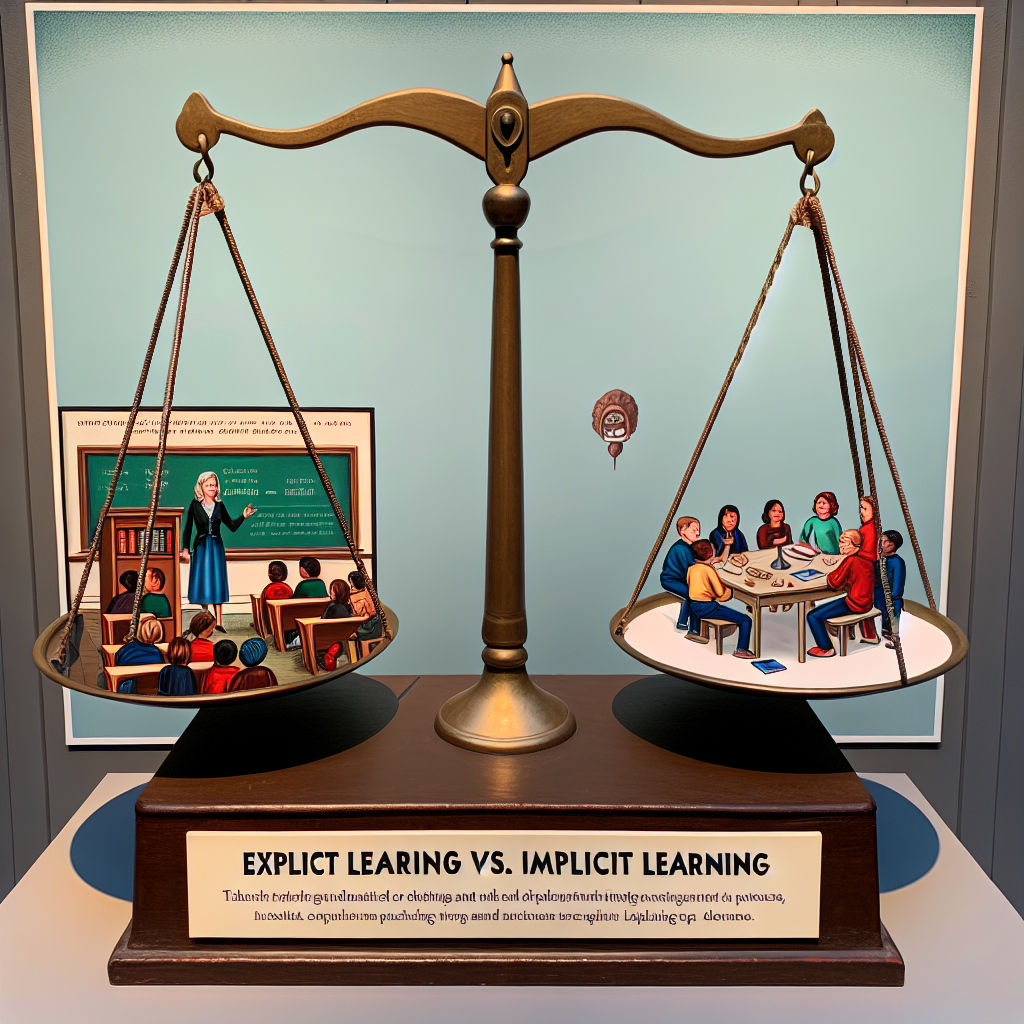
Introduction
In our ever-evolving world, the ways we absorb and apply knowledge are more vital than ever. Explicit Learning vs. Implicit Learning: What’s the Difference? is a question that’s crucial for educators, students, and professionals alike. Understanding these two styles of learning not only enhances our ability to teach and learn effectively, but it can also affect how we approach everyday life and problem-solving.
Imagine you’re in a classroom—one that employs different teaching strategies tailored for various learners. Or picture yourself engaged in a new hobby, consciously practicing skills and drawing on previous knowledge. Both scenarios embody the unique characteristics of explicit and implicit learning. Let’s delve into this fascinating topic to uncover the differences, benefits, and real-world applications of each approach.
What is Explicit Learning?
Explicit learning refers to a process where information is learned intentionally, with conscious effort and awareness. It often involves structured settings like classrooms, where the learner is aware of what they are studying. This method can include activities like taking notes, memorizing facts, or engaging in discussions.
Characteristics of Explicit Learning
- Conscious Awareness: Learners actively engage with the material.
- Structured Learning Environment: Often takes place in classrooms or training environments.
- Feedback-Oriented: Involves immediate feedback on performance, allowing for corrections and adjustments.
Case Study: Language Learning
Consider a classroom where students are learning French. The teacher provides grammar rules, vocabulary lists, and structured exercises. Students are aware that they need to study these elements to pass their exams. Here, explicit learning manifests clearly—the process is intentional, and the goals are well-defined.
Benefits of Explicit Learning
- Clarity and Structure: Offers clear guidelines and learning goals.
- Measured Progress: Easier to assess progress and mastery of concepts.
| Benefit | Description |
|---|---|
| Clarity | Clear learning objectives make the process easier. |
| Assessment | Allows for measurable outcomes through tests and quizzes. |
What is Implicit Learning?
Implicit learning, in contrast, occurs without the learner’s conscious awareness. This type of learning typically happens in informal settings or when individuals are engaged in everyday activities. It’s about absorbing information subconsciously, which can lead to knowledge that is not readily verbalized.
Characteristics of Implicit Learning
- Unconscious Absorption: Learners absorb knowledge without active engagement.
- Informal Context: Often occurs naturally in social interactions or through experience.
- Long-Term Retention: Information learned in this way can often be retained longer, as it becomes ingrained in daily behavior.
Case Study: Learning to Ride a Bicycle
When learning to ride a bike, individuals generally do not memorize rules or physics; instead, they practice until balancing becomes second nature. The muscles and motor skills learn implicitly, often without the person realizing it.
Benefits of Implicit Learning
- Natural Integration: Knowledge becomes part of daily life and behavior seamlessly.
- Longer Retention: Information learned is often retained longer and recalled effortlessly.
| Benefit | Description |
|---|---|
| Natural Integration | Skills and knowledge blend into everyday activities. |
| Long-Term Retention | Knowledge persists without conscious effort to recall. |
Explicit Learning vs. Implicit Learning: Key Differences
Understanding the distinctions between these two types of learning is essential. Here’s a table that summarizes the key differences:
| Feature | Explicit Learning | Implicit Learning |
|---|---|---|
| Awareness | Conscious | Unconscious |
| Method | Structured, often formal | Informal, natural |
| Environment | Classroom or guided settings | Everyday life, social experiences |
| Retention | Often shorter-term; requires effort | Longer-term; integrated into behavior |
| Example | Studying for a test | Learning a dance through practice |
Which is More Effective?
The effectiveness of explicit vs. implicit learning largely depends on the context and the individual. Some tasks require explicit instruction to ensure quality and understanding, while others may benefit from the fluid nature of implicit learning.
When to Use Explicit Learning
- Mastering Foundational Knowledge: For learning the basics of a subject, like mathematics or grammar.
- Skill Acquisition: Useful when precise knowledge is needed, such as programming languages.
When to Use Implicit Learning
- Motor Skills Development: Activities that require physical skills, like sports or dance.
- Social Learning: Building understanding of social norms and behaviors primarily through exposure.
Combining Explicit and Implicit Learning
Interestingly, the most effective learning approaches often incorporate both types. By using explicit instruction to lay the groundwork for knowledge, followed by implicit practice, learners can deepen their understanding and retention. This combined method can be especially effective in complex fields like music, languages, and sports.
Example: Learning a Musical Instrument
When learning an instrument like the piano, a student first benefits from explicit lessons on theories, scales, and pieces. Once comfortable, they can engage in implicit learning through practice, repetition, and intuitive play. Over time, this combination leads to a well-rounded musical ability.
Conclusion
Understanding Explicit Learning vs. Implicit Learning: What’s the Difference? provides invaluable insights for educators, students, and anyone interested in bettering their learning strategies. Both methods hold unique advantages and can be tailored to fit individual needs.
Remember, it’s not about choosing one over the other; it’s about recognizing when each strategy is most effective. By integrating explicit and implicit learning techniques, anyone can enhance their understanding, retention, and application of new information and skills.
Actionable Insights
- Assess Your Learning Style: Reflect on how you learn best and adjust your strategies accordingly.
- Practice Integratively: Use explicit learning for foundational skills but incorporate implicit strategies for mastery.
- Engage in Diverse Experiences: Broaden your learning through various methods, including informal social contexts.
FAQs
1. What are practical examples of explicit learning?
Explicit learning can be seen in classrooms where students engage in lectures, discussions, and structured activities like quizzes or tests.
2. What are some practical examples of implicit learning?
Learning to navigate social situations or acquiring a new language naturally, through exposure and interaction, exemplifies implicit learning.
3. Can children benefit from both explicit and implicit learning?
Absolutely! Children often learn best through a mix of both methods—structured lessons for foundational skills and interactive play for natural skill development.
4. How can I shift my learning approach to incorporate both methods?
Try starting with explicit instruction to grasp new concepts, then practice in real-world situations to reinforce that knowledge organically.
5. Are there any tools or strategies to enhance implicit learning?
Engaging in activities that promote immersion—such as language immersion programs or hands-on workshops—can help enhance implicit learning.
By diving deep into this intriguing topic, we’ve uncovered the nuances of explicit and implicit learning. Armed with this knowledge, you can tailor your learning and teaching strategies to boost understanding and retention. Make the most of each method, and watch your skills and knowledge grow!














